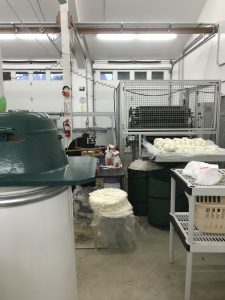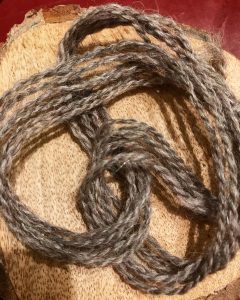This past week, I tried as much as possible to focus on the wool industry and I believe I was able to stay focused on that topic pretty successfully given just how much there is to study.
I began the week by visiting Olympic Yarn and Fiber (a detailed post about that visit can be found here). This was the perfect way to begin a week of intensive wool studying as I was able to witness the wool processing procedure in person and was incredibly helpful during the rest of the week while I was trying to piece together an understanding of an incredibly vast and diverse subject. From a business perspective, it was interesting to see a modern day “cottage industry” that still utilizes modern day technology.

To me, it is absolutely mind blowing how much work is required to process fleece into a modern day garment and even more staggering still how much work was poured into processing and crafting wool textiles without the use of machinery. As I continue to gain a more in depth understanding of the various different stages in the lifecycle of a garment, it has become more than obvious that industrialization was the key to fashion for the sake of aesthetics rather than functionality and durability. Without machines to see out the processes for us, there is no conceivable way that we could have the surplus that we do now.
It has also struck me that in many ways, mechanization symbolizes a loss of consciousness when it comes to textiles. Before textile mills began to pop up across the globe, textiles were localized in a way that I think many of us cannot quite understand. In many cultures, sheep were from local pastures, having gradually adapted to the environment and climate of a given place, the fleece spun and knitted by mothers who knew the sheep well, looking to keep their children, husbands, and loved ones warm and protected from the elements (I could write a whole new post about the gender roles associated with wool crafts, which I will likely do before this study is over). Don’t get me wrong, I am in no way glorifying the need to engage in hours of tedious spinning and knitting as a way of survival. However, I do believe there is something to be said for a crafter knowing where their materials are from and having a connection to where the finished product is going – Olympic Yarn and Fiber is an example of a modern day model of a similar structure.

I continue to have a love/hate relationship with what I know to be true about the industrialization of textiles and this past week of study has done nothing to polarize either of those feelings. It has incredible to read about how survival crafts have evolved into lucrative businesses for peoples who have had little options in the past, but at the same time the impact of other forms of industrialized crafts continue to leave me with pause before celebration the various different ‘advancements’ of humankind.